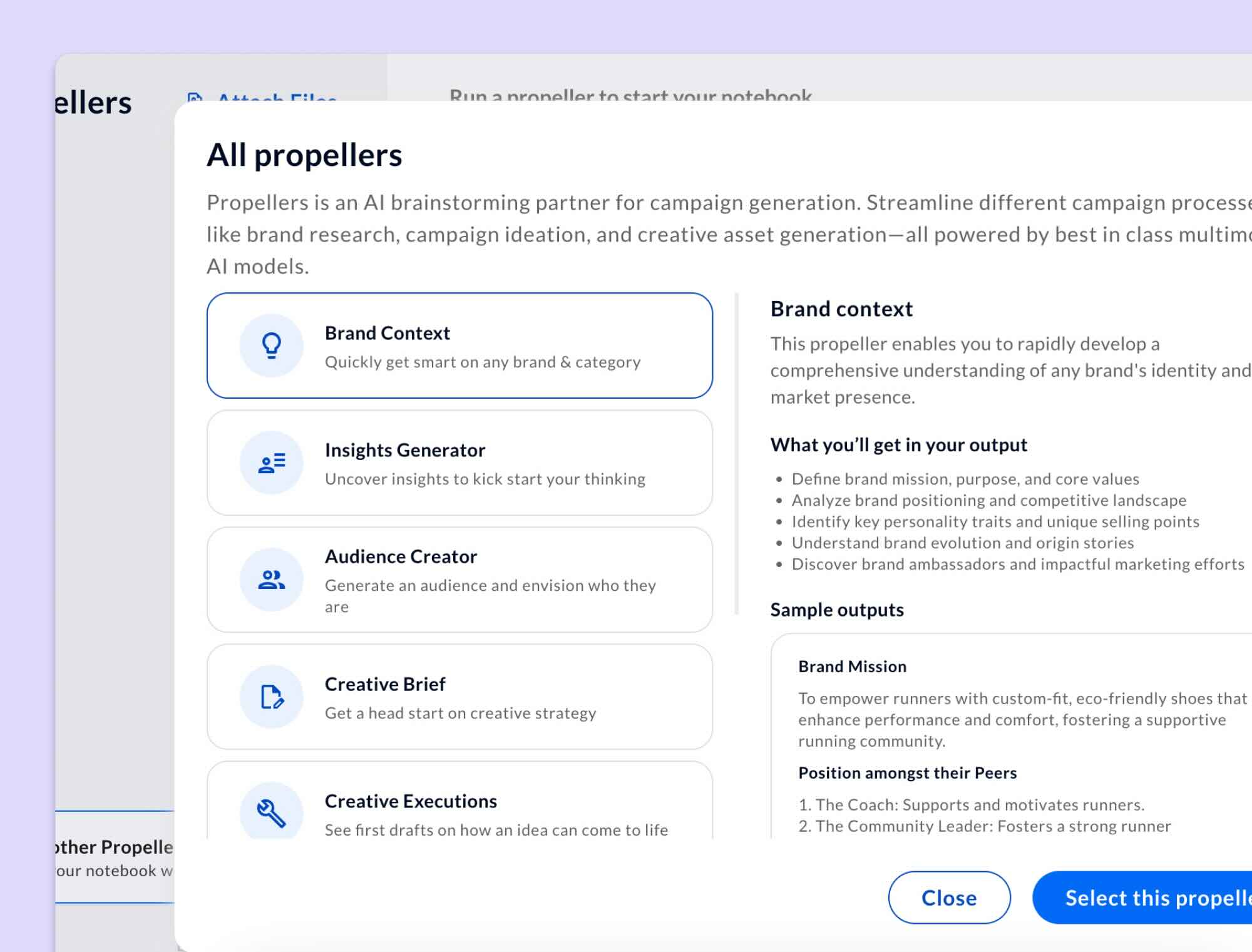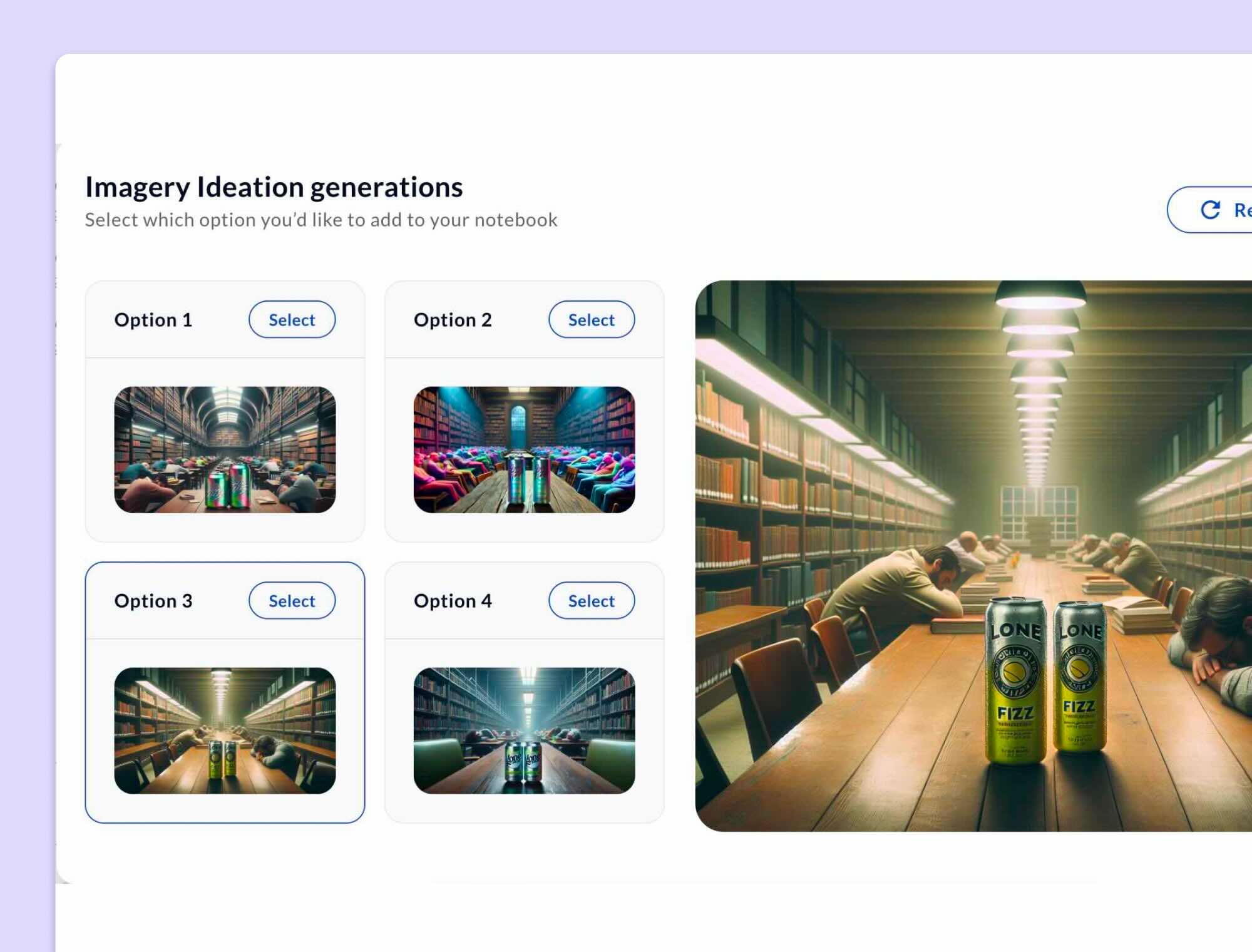
GenAI tools are everywhere, though the best ones are purpose-built. That means they’re not one-size-fits-all LLMs, but rather sharply tuned programs made to excel at specific tasks.
Yes, if you’re a marketer, you could toggle and bounce between various applications—ChatGPT or Gemini to help polish copy, Midjourney to spin up visual assets. The problem is that there’s little shared communication between these platforms, and the quality of outputs depends on your skill as a prompt engineer.
Enter a tool like Propellers, part of The Marketing Cloud Platform. It’s a creative-brainstorming partner that lets you add distinct layers to a project, from generating a creative brief to building an audience and drafting inventive visual assets.

Whether you’re a new brand preparing to GTM or an existing brand planning a holiday campaign, Propellers is the perfect shared environment for your team. Let’s take a look at how it works.
For the purposes of this article, I’m going to be the Head of Brand for a freshly launched, Austin, TX-based seltzer called Lone Fizz. (Haven’t heard of us? We’re effervescent!)
Now, this is obviously a crowded market, so I’ll want to start fleshing out what the USPs of my product are, and how it’s positioned within that larger bubbly-water landscape.
I add a “Brand Context” propeller to my notebook, and then start brushing up on my competition. Propellers lets me drill down on brand context for anyone within my competitive space, summarizing facets like brand personality, positioning, values, and mission.
A quick snapshot of the viral seltzer Liquid Death, for instance, highlights influencers who have worked with the brand, and stresses the values-driven environmental mission to ditch plastic bottles in favor of metal cans.
Topo Chico, meanwhile, is a legacy brand launched in 1895 that has become a hip seltzer-of-choice despite its fairly straightforward marketing and presentation. But Propellers research reminds me that Coca-Cola acquired the brand in 2017, which could alienate consumers who thought they were getting an independent seltzer…a slice of market share that I could tempt over to Lone Fizz?
When I’m ready to turn the focus on my own brand, I can quickly upload existing files and documentation that give context to Lone Fizz—things like brand guidelines, a mission statement, or taglines my copywriter has been riffing on.
I give Propellers some positioning notes, focusing on Lone Fizz’s collaborations with artists to create limited-edition cans, our focus on metal-over-plastic for the sake of the environment, and more.
Within seconds, I’ve got a draft document sketching out possible brand mission, values, personality, and competitive set. It’s a solid start that I can take to my team as we continue hashing out the way we want Lone Fizz Seltzer to arrive on the market.

The Insights Generator propeller lets me build on the brand context I’ve already generated, by introducing specific “problems” that Lone Fizz could face as we launch.
I start with the elephant in the room: How oversaturated the seltzer market is, making it increasingly tough for an upstart to even get noticed. Propellers responds with ways to lean into my USPs (like being an independent beverage brand from Austin) and a list of cliches from the category to avoid (like bland “nature” imagery, lackluster flavor descriptions, and overuse of the adjective “refreshing”).
From there, I take a look at one of seltzer’s downsides: It’s ultimately a pretty boring drink. Liquid Death has countered this by making their marketing over-the-top and absurdist, but it’d be cringe to copy that playbook, not that others haven’t tried.
Propellers tackles the problem of boredom in an interesting way. I’m struck by one poetic aside in the “Shower Thoughts” category: “Seltzer is the only drink that can be both boring and exciting at the same time.”
There’s a kernel there I can work with. I scribble out the single sentence on my whiteboard and set a meeting with Lone Fizz’s CMO, hoping that it’ll spark a direction for our launch campaign.
Now that Lone Fizz has a foundation to work with, I can start drafting a creative brief for our launch campaign. I’ve decided to focus on so-called “sober curious” college students looking for NA beverage choices.
Propellers defines my audience (“students in search of authentic, low-calorie, stylish alternatives to typical party drinks”) and my main task (“Turn Lone Fizz from just a drink into the ultimate cooler statement”).
I’m fond of the proposed CTA—“Sip Beyond Ordinary”—and the brief’s focus on positioning the seltzer can as a canvas for creativity and self-expression, perhaps connected directly to Austin as a hotbed of the arts.
Multimodal LLMs—ones that can generate both text and image, for instance—are growing increasingly powerful. This doesn’t mean that anyone can suddenly produce print-ready assets without any design training.
Think of Propeller’s image ideation features as a way to conjure a targeted mood board of references, based on brand guidelines, personality, and vibes. I don’t know my way around Adobe Photoshop or Figma very well, but with Propellers I’m able to generate stunning draft images that can then be elevated by my Creative team.

There are three main ways you can tap Propellers to brainstorm visual assets:
•Imagery ideation: Create draft images for ads (customizable to common social platform dimensions) or for prospective packaging design. Images can be further edited and tweaked using an interface with Adobe Express.
•Model shoots: Iterate with AI-generated human models, tailored to demographic specs.
•Variants: Take an existing image, like a product shot, and seamlessly switch out backgrounds.
Within minutes, I’m able to spin up packaging inspirations for Lone Fizz, informed by a few reference images I’ve earmarked for inspo.
I can then visualize those in different contexts (nestled in an ice-filled cooler, sitting on the edge of a picnic table), and create scenarios with virtual human models that can be executed by my Creative Director.
For instance—building on the “seltzer as both boring and exciting at the same time” concept that Propellers generated earlier—I envision two beverage cans on the table of a drab library where everyone is asleep, desperate for some Fizz.
From there, I can export these ideas into other GenAI platforms to create additional reference points for my Creative team. Google’s Veo3 is handy for turning my Propellers-inspired prompt and tagline into easy-to-share video inspo for future ad spots. In the near future, Veo3's video creation will be fully integrated into Propellers—stay tuned.
Propellers is part of The Marketing Cloud Platform, an integrated suite of solutions across creative, media, comms, and research. To explore further, we recommend signing up for the platform—it's free, quick, and easy—and exploring the full marketplace.